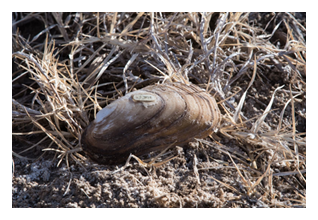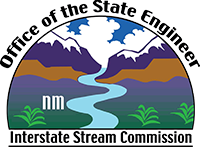Interstate Stream Commission
- OSE Home
- About ISC
- Basins
- Pecos River Basin
- Threatened and Endangered Species
Threatened and Endangered Species in the Pecos River Basin
Texas hornshell (Popenaias popeii)
 Species Status and Distribution: From Final Listing Rule, 2018) The Texas hornshell (Popenaias popeii) was listed by the U. S. Fish and Wildlife Service (USFWS) as a federally endangered species on February 9, 2018 (83 FR 5720). Historically, the Texas hornshell was known to occur throughout the Rio Grande drainage system; however, there are currently only 5 remaining populations (one in New Mexico, two in Texas, and two in the Rio Grande along the Texas-Mexico border). The New Mexico population is found exclusively in an 8.7-mile reach of the Black River south of Carlsbad, and has been estimated to have a relatively stable population of about 48,000 individuals, making it one of the healthier of the 5 populations (83 FR 5722). There is also an experimental population being reintroduced to the lower reaches of the Delaware River on the Texas-New Mexico border.
Species Status and Distribution: From Final Listing Rule, 2018) The Texas hornshell (Popenaias popeii) was listed by the U. S. Fish and Wildlife Service (USFWS) as a federally endangered species on February 9, 2018 (83 FR 5720). Historically, the Texas hornshell was known to occur throughout the Rio Grande drainage system; however, there are currently only 5 remaining populations (one in New Mexico, two in Texas, and two in the Rio Grande along the Texas-Mexico border). The New Mexico population is found exclusively in an 8.7-mile reach of the Black River south of Carlsbad, and has been estimated to have a relatively stable population of about 48,000 individuals, making it one of the healthier of the 5 populations (83 FR 5722). There is also an experimental population being reintroduced to the lower reaches of the Delaware River on the Texas-New Mexico border.
Species Description:The Texas Hornshell is a 3-4” long freshwater mussel, typically dark brown to green.
Ecology: (From Final Listing Rule, 2018) Female mussels retain fertilized eggs within a specialized gill chamber until they have developed into a larval stage. Mature larva, called glochidia, are obligate parasites that depend upon a fish host to continue development. Once released, the larvae attach to the gills of nearby fish, forming cyst-like structures where they develop into juvenile mussels over weeks or months before dropping to the riverbed. Primary host fish species for the Texas hornshell are the river carpsucker (Carpoides carpio), gray redhorse (Moxostoma congestum), and red shiner (Cyprinella lutrensis). Only mussels that drop onto a suitable habitat will survive. Maximum lifespan of the Texas hornshell is estimated to be at least 20 years.
Habitat: (From Final Listing Rule, 2018) Mature mussels live in atypical habitat for a mussel species, requiring sheltered refuges to escape from extreme flows in the region’s flashy, flood-prone rivers. Texas hornshell are typically found in rock crevices and under large boulders, travertine shelves, or undercut banks, rather than in riffle gravel beds, as is more common for other mussel species.
Conservation: Prior to the designation of the Texas hornshell as an endangered species, two Candidate Conservation Agreements with Assurances (CCAAs) were developed for the species. CCAAs are voluntary agreements between a regulatory agency and private landowners and/or other entities. In exchange for voluntary implementation of conservation measures defined in the agreement, participants receive assurances that they will not be required to undertake additional, potentially unplanned conservation steps if a candidate species is designated in the future. CCAAs use the risk of a future designation and accompanying enforcement actions to induce voluntary conservation actions before the candidate species is designated. The CCAAs provide a proactive suite of conservation actions rather than reactive actions responding to a designation, and may also prevent a future designation.
Following the Texas hornshell’s listing as a candidate species, two CCAAs were developed: One CCAA was developed jointly by the USFWS and the Center for Excellence in Hazardous Materials Management (CEHMM), and pertains to private and federal lands, and the other was developed by the New Mexico State Land Office (SLO) and pertains to New Mexico State Trust lands.
The New Mexico Interstate Stream Commission is a participant in the USFWS/CEHMM CCAA, due to the state’s possession of water rights within the area of concern. Conservation activities in the CCAA are funded by fees paid by participants from the oil and gas industry, while other landowners provide in-kind contributions, in the case of Water Withdrawer Participants by limiting pumping when needed, in order to preserve river flows, and in the case of Agriculture and Ranching participants, by allowing access for species monitoring and allowing conservation activities on their land. NMISC staff serve as representatives on the CCAA’s Stakeholder Committee and Technical Working Group.
On December 15, 2020, the USFWS promulgated a Draft Recovery Plan for the Texas Hornshell; the Final Recovery Plan was released on May 9, 2022. A Proposal for designation of critical habitat for the hornshell was released on June 10, 2021, but the final designation of critical habitat has not yet been released.
U.S. Fish & Wildlife Service Species Profile – Texas hornshell
Endangered Species Status for Texas Hornshell; Final Listing Rule , 83 FR 5720-5735 (February 9, 2018)
Other Species
There are several other endangered and threatened species in the basin, both aquatic and terrestrial, including the Pecos Sunflower (Helianthus paradoxus), Pecos Gambusia (Gambusia nobilis), Pecos Springsnail (Pyrgulopsis pecosensis), and others.
